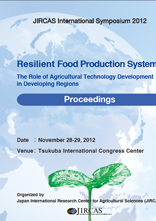Conservation Agriculture in China and Impacts on Yields of Maize

China is one of the countries which have been seriously endangered and affected by desertification in
the world. The soils in the dryland areas are severely suffered from degradation and desertification. Water
and wind erosions are the main factors for the soil deterioration. The threat of water erosion in dryland
areas is affected by the amount and intensity of rainfall, the type of irrigation, the erodibility of the soil,
cropping and management factors, and erosion control practices. In recent decades, sand storms in China
have also done great harms to the farmland. As affected by all the reasons mentioned above, the
desertification of farmland finally caused the decline of productivity.
In Northeast China, spring maize is one of the most important grain crops where annual rainfall varies
from 400 to 1,000mm and the average cumulative evaporation is about 1,800mm, which is about 4 times
higher than the average total rainfall received during the growing stage of spring maize which causes low
status of soil moisture in the root-zone usually limits productivity of spring maize. In North China Plain
around Beijing, since 1980s the cropping system in this region has changed from a single to a doublecropping
system (winter wheat-summer maize) where the annual cumulative evaporation hugely exceeds
the annual rainfall. Therefore, the needed water for the plants is largely increased causing water scarcity.
In farming-pastoral ecotone of Inner Mongolia large areas of grassland have been converted into cropland
due to increased population and food demand. The conversion of grassland to cropland combined with
insufficient rainfall and wind erosion have resulted in serious soil nutrient depletion and structural
deterioration. In Northwest China areas where the average precipitation varies from 40 to 200mm, water
shortage is definitely one of the major constraints to the production of spring wheat which is the major
cereal crop of the region. Conventional tillage in dryland farming areas of China includes mouldboard
ploughing to a depth of about 20cm, followed by harrowing, hoeing, rolling and levelling. All the residues
in the fields are removed for animals or as fuel before ploughing. In some parts of northern China,
particularly in North China Plain, burning crop residue has increased during the last decades. Long term
mouldboard ploughing and residue removal/burning have increased the risks of wind and water erosion
and the formation of hard pan in the deep soil layer. Also it has resulted in poor soil physical and chemical
properties, high inputs of energy and labour which apparently leads to low farmer incomes. To solve all
these problems, various kinds of Conservation Agriculture (CA) treatments are used in these dryland
areas, such as the no/minimum tillage, controlled traffic tillage treatments and permanent raised beds
(PRB).
This paper will talk about 20 years of conservation agriculture in China. Different kinds of CA machines
were developed which made CA is possible in China; impacts of conservation agriculture on yields,
environment are great which makes CA accepted, restraint of CA will be also mentioned.
| Date of issued | |
|---|---|
| Creator | Hongwen Li Jin He Qingjie Wang |
| Subject |
Conservation agriculture dryland areas no tillage sustainable soil management China |
| Publisher | Japan International Research Center for Agricultural Sciences |
| Available Online | |
| Issue | 2012 |
| spage | 94 |
| epage | 109 |
| Rights | Japan International Research Center for Agricultural Sciences |
| Language | eng |
